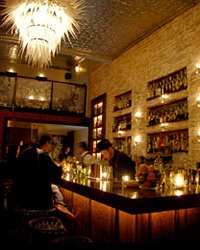 Justin Lew
From Boston to San Francisco, once-fringe neighborhoods now beckon with cool clubs, groundbreaking restaurants, and secret hot spots.
Justin Lew
From Boston to San Francisco, once-fringe neighborhoods now beckon with cool clubs, groundbreaking restaurants, and secret hot spots.
See our slideshow of America’s Best Secret Neighborhoods.
“The suit-and-tie crowd has a little trouble here,” says David Bishop, owner of Atlanta’s 97 Estoria bar, “but everyone else has a blast.” The here Bishop is referring to is Cabbagetown, an historic quarter with factory-worker housing, abandoned warehouses, a dwindling drug trade—and some of the hottest spots in Atlanta. Cabbagetown is Atlanta’s next big thing.
Areas like Cabbagetown—artsy, foodie, edgy, and brand spanking new—are blooming in cities around the country. After years of decline in the post-WWII era of big suburbs, bigger houses, and even bigger cars, America’s neglected urban areas are finally experiencing a renaissance-according to the U.S. Census, almost every major city has grown in the past 10 years. Welcome to the 21st century, the Era of Urban Emergence.
“Most of the established areas are all bought-out and very expensive. So folks are driven to seek out ‘secondary’ neighborhoods,” says Doug Farr, author of Sustainable Urbanism (Wiley, 2008), a primer for environmentally friendly design in these newly booming cities.
Travelandleisure.com searched from coast to coast to uncover the country’s most happening ‘hoods—formerly downtrodden parts of town that are currently enjoying a renaissance, like the Belmont in Charlotteville, Pilsen in Chicago, and downtown Kansas City. And while New York City, with its five boroughs and eight million souls, is bound to be nurturing several areas at any given time, Prospect Heights, in Brooklyn, takes the cake. Long home to a mixed demographic—including a strong Caribbean community—Prospect Heights now also welcomes young Manhattan expats and Brooklyn bargain-hunters into its brownstone embrace.
“I originally moved here for good subway and park access,” says Eric Herman, a music producer who moved to Prospect Heights just over a year ago. “Since then, a wine bar, a beer garden, and at least half a dozen restaurants have opened—this place is blowing up!”
Further to the west in Texas, the epicenter of artsy alternative culture may be Austin, but its East End neighborhood is ground zero. “The East End is an area with incredible cultural history and, until recently, a pretty dodgy present,” says Beth Krauss, from Austin’s Convention and Visitors Bureau. “Now, though, it has become the city’s ’it’ area—the pulse of Austin’s progressive arts and nightlife scene.”
While gentrification is inevitable in the era of urban emergence, it can also be a force for good. Ideally, new residents invest in the neighborhood emotionally as well as economically—they complement its existing charms by restoring old buildings and opening exciting new businesses. It is precisely the eclectic mixture of old and new that makes these places so distinctive: not too shabby, not too chic, the hotbeds of what’s good in that city.
So, visit these neighborhoods on the rise as soon as you can: the change from cutting edge to can’t-get-a-dinner-reservation will happen before you know it.